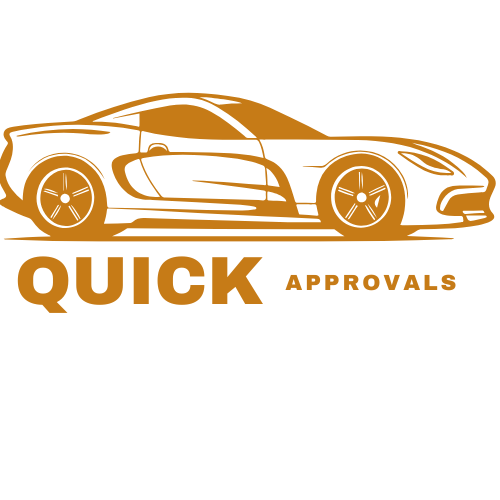Navigating the process of securing a car loan for trade-in cars Canada is a critical step for Canadians looking to upgrade their vehicle while managing finances wisely. This approach allows you to leverage the value of your current car to reduce the cost of a new one, potentially lowering the amount you need to borrow.
Whether you’re trading in a fully paid-off vehicle or one with an outstanding loan, understanding the nuances of this process can save you money and streamline your purchase. This guide provides an in-depth look at how trade-ins work with car loans, the impact of equity, tax benefits, and practical steps to get the best deal. For tailored financing options, visit Quick Approvals.
How Does a Car Loan with Trade-In Canada Work?
When you trade in a car, the dealership appraises its value and offers a trade-in amount, which is applied toward your new vehicle purchase. If you have an existing loan on the trade-in, the process involves:
- Paying Off the Existing Loan: The trade-in value first settles any outstanding loan balance.
- Applying Remaining Value: Any surplus (positive equity) acts as a down payment, reducing the new loan amount.
- Handling Negative Equity: If you owe more than the car’s value, the difference is added to the new loan, increasing your payments.
For example, if your car is valued at $15,000 and you owe $9,000, the dealership pays off the loan, leaving $6,000 as a down payment. Conversely, if you owe $25,000 but the car is worth $20,000, the $5,000 negative equity is rolled into the new loan, raising the total to finance.
Understanding Positive and Negative Equity
Equity is the difference between your car’s trade-in value and the remaining loan balance:
- Positive Equity: If your car is worth more than you owe (e.g., $15,000 value, $10,000 loan), you have $5,000 in positive equity. This reduces the amount you need to borrow, potentially lowering interest costs and monthly payments.
- Negative Equity: If you owe more than the car’s value (e.g., $20,000 loan, $15,000 value), you have $5,000 in negative equity. This amount is added to your new loan, increasing your debt and monthly payments. In Q4 2023, 20.4% of new-car trade-ins in Canada had negative equity, averaging $6,064, according to industry data.
Knowing your equity status is crucial before trading in. If negative equity is significant, consider paying down the loan or selling the car privately for a potentially higher price.
The Trade-In Process for a Car Loan Options for Trading in a Car Canada

Car Loan Options for Trading in a Car Canada, The trade-in process in Canada involves several steps to ensure a smooth transaction:
- Vehicle Appraisal: Take your car to a dealership for an appraisal. They assess its condition, mileage, and market demand to determine its value.
- Loan Balance Check: Contact your lender to confirm the payoff amount for your current loan.
- Negotiation: Compare trade-in offers from multiple dealerships to maximize value. Tools like Canadian Black Book can provide a baseline estimate.
- Apply Trade-In Value: The agreed-upon value is deducted from the new car’s price, reducing the loan amount.
- Finalize Financing: Secure a car loan for trade-in cars Canada for the remaining balance, either through the dealership or a lender like a bank or credit union.
Maintaining your car’s condition (e.g., addressing minor repairs) can boost its trade-in value, making the process more financially favorable.
Tax Benefits of a Car Loan with Trade-In Canada
One significant advantage of trading in a car in Canada is the tax savings. When you trade in a vehicle, the trade-in value is subtracted from the new car’s price before calculating sales tax (GST/HST or PST, depending on the province). For example:
- New car price: $30,000
- Trade-in value: $10,000
- Taxable amount: $20,000
- In Ontario (13% HST), tax savings: $1,300 (13% of $10,000)
This tax benefit, often called a “trade-in tax credit,” applies in provinces like Ontario and British Columbia. For detailed information on GST/HST for vehicle transactions, refer to the Canada Revenue Agency’s guide.
Types of Car Loan Options for Trading in a Car Canada
Several car loan types are available in Canada, each suited to different needs when trading in a vehicle:
- New Car Loans: Typically offer lower interest rates (e.g., 5–7%) due to lower risk, ideal if trading in for a new vehicle.
- Used Car Loans: Slightly higher rates (e.g., 6–9%) for pre-owned vehicles, common when trading in for another used car.
- Refinancing Loans: Allow you to renegotiate terms on an existing loan, potentially useful before trading in.
- Lease Buyout Loans: For purchasing a leased vehicle at the end of the lease term, relevant for those considering a car loan for trading in a leased car Canada.
To explore financing options, check out RBC Royal Bank’s car loan page for competitive rates and terms.
How to Secure the Best Car Loan Rates for Trade-In Vehicles Canada
Best Car Loan Rates for Trade-In Vehicles Canada, To get the best rates on a car loan for trade-in cars Canada, consider these strategies:
- Improve Your Credit Score: Pay bills on time and reduce credit card balances to boost your score, which can lower interest rates.
- Increase Down Payment: A higher down payment, including your trade-in value, reduces the loan amount and may secure better terms.
- Compare Lenders: Shop around at banks, credit unions, and online lenders. Dealerships may offer competitive rates but could prioritize higher-commission loans.
- Choose Shorter Terms: Shorter loan terms (e.g., 36 months) often have lower interest rates than longer terms (e.g., 72 months), saving on total interest.
- Negotiate: Don’t accept the first offer; negotiate with dealers and lenders for better rates or trade-in values.
The Role of Credit Scores in Car Loan with Trade-In Canada
Your credit score significantly impacts loan approval and interest rates:
- Excellent (760–900): Qualifies for the lowest rates and best terms.
- Good (720–759): Slightly higher rates but still favorable.
- Fair (660–719): Higher rates; some lenders may require a co-signer.
- Poor (Below 660): Approval is challenging, with high rates; subprime lenders may be an option.
A strong credit score can enhance your ability to secure a car loan with trade-in Canada, especially when combined with positive equity from your trade-in.
Comparing Trade-In Values Across Dealerships
To maximize your trade-in value:
- Get Multiple Quotes: Visit several dealerships for appraisals, as offers vary based on inventory needs.
- Maintain Vehicle Condition: Clean the car and address minor repairs to increase its value.
- Research Market Value: Use tools like Canadian Black Book to estimate your car’s worth and negotiate effectively.
Comparing offers ensures you get the most value, directly impacting the cost of your car loan for trade-in cars Canada.
Legal Considerations for a Car Loan for Trading in a Leased Car Canada

Car Loan for Trading in a Leased Car Canada, Trading in a leased car or one with a loan involves legal considerations:
- Ownership and Liens: Ensure the vehicle title is clear, except for the existing loan or lease agreement.
- Disclosure: Disclose any accidents or mechanical issues to avoid legal disputes.
- Contract Review: Scrutinize the trade-in and loan contracts for fees, terms, and how the trade-in value is applied.
- Provincial Regulations: In Ontario, the Consumer Protection Act ensures transparency in vehicle transactions, protecting consumers from unfair practices.
Common Mistakes to Avoid with a Car Loan for Trade-In Cars Canada
Avoid these pitfalls to ensure a smooth process:
- Ignoring Negative Equity: Trading in with significant negative equity can inflate your new loan, increasing costs.
- Not Shopping Around: Accepting the first trade-in or loan offer may result in less favorable terms.
- Overlooking Fees: Some dealerships may charge administrative fees that reduce your trade-in value.
- Skipping Research: Not knowing your car’s market value can lead to accepting a low offer.
- Rushing the Process: Take time to review contracts and compare financing options to avoid costly mistakes.
Using a Car Loan Calculator with Trade-In Canada
A car loan calculator with trade-in Canada helps estimate monthly payments by factoring in the trade-in value, loan amount, interest rate, and term. For example, if you’re financing $20,000 after a $10,000 trade-in at 5% interest over 60 months, a calculator can show your monthly payment (approximately $377) and total interest paid. These tools, available on bank websites like RBC, help you plan your budget effectively.
Is It Better to Trade In a Car or Sell It When Getting a Car Loan in Canada?

Deciding whether to trade in or sell privately depends on your priorities:
- Trade-In Pros: Convenient, tax savings, dealership handles loan payoff.
- Trade-In Cons: Lower value compared to private sales, potential for negative equity issues.
- Private Sale Pros: Potentially higher sale price, more control over the process.
- Private Sale Cons: Time-consuming, requires handling paperwork and loan payoff independently.
If convenience and tax savings are priorities, trading in is often better. For maximum value, selling privately may be worth the effort, especially if you have positive equity.
How Does Trade-In Affect Car Loan in Canada?
A trade-in impacts your car loan by:
- Reducing Loan Amount: Positive equity lowers the amount you need to borrow.
- Increasing Loan Amount: Negative equity adds to the new loan, raising payments.
- Affecting Interest Rates: A lower loan amount due to a trade-in may qualify you for better rates.
- Tax Implications: Reduces taxable amount, lowering overall costs.
Understanding these impacts helps you make informed decisions when securing a car loan for trade-in cars Canada.
Q&A Section
1. How to Get Car Loan with Trade-In Canada?

To secure a car loan with trade-in Canada, start by getting your vehicle appraised at a dealership. The trade-in value offsets the new car’s price, acting as a down payment. Provide documentation like your driver’s license, proof of income, and vehicle title. Compare loan offers from banks, credit unions, or dealerships to find the best terms. For more details, visit Quick Approvals.
2. What Are the Requirements for Car Loan with Trade-In in Canada?

Requirements for a car loan with trade-in in Canada include:
Good credit score (preferably 660+).
Proof of income (e.g., pay stubs).
Vehicle documentation (title, registration, loan details).
Trade-in appraisal from a dealership.
Lenders may also require a Canadian driver’s license and proof of residency. Check with lenders like RBC for specific criteria.
3. Can I Use Trade-In as Down Payment for Car Loan Canada?

Yes, you can use your trade-in as a down payment for a car loan for trade-in cars Canada. The trade-in value reduces the purchase price, lowering the loan amount. For example, a $10,000 trade-in on a $30,000 car means you finance $20,000, potentially improving loan terms.
4. How Does Trade-In Affect Car Loan in Canada?
A trade-in affects a car loan for trade-in cars Canada by reducing the loan amount if you have positive equity or increasing it with negative equity. It also lowers sales tax, as you pay tax only on the net price after the trade-in. Use a car loan calculator with trade-in Canada to estimate payments.
5. Is It Better to Trade In a Car or Sell It When Getting a Car Loan in Canada?
Whether to trade in or sell privately depends on your goals. Trading in offers convenience and tax savings but may yield a lower value. Selling privately could fetch a higher price but requires more effort. For financing options, explore Quick Approvals.
Conclusion
Securing a car loan for trade-in cars Canada involves understanding your vehicle’s equity, the trade-in process, and tax benefits. By comparing trade-in offers, improving your credit score, and exploring financing options, you can minimize costs and secure favorable terms. Whether you have positive or negative equity, careful planning ensures a smooth transaction. For personalized financing solutions, visit Quick Approvals to explore your options. For authoritative insights, refer to resources like the Canada Revenue Agency or RBC Royal Bank.


